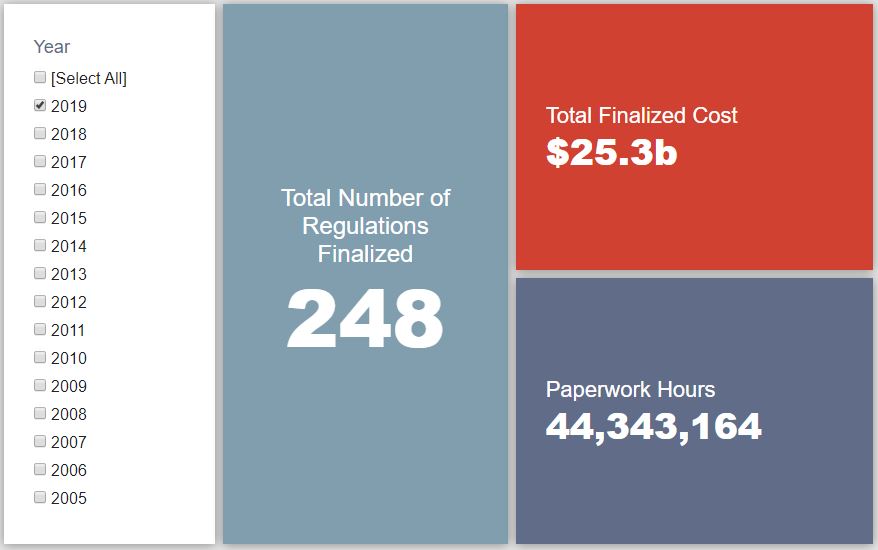Week in Regulation
November 25, 2019
Deregulatory Proposal Dominates Week
This past week brought a notable spike on the cost-savings side of the ledger – from just one proposed rule. An Environmental Protection Agency (EPA) proposal led the way with nearly $2 billion in net present value cost savings. Outside of simply publishing rules, the administration also released the fall edition of the Unified Agenda, its regulatory plan for the coming year. Across all rulemakings, agencies published $1.7 billion in total net cost savings but added 194,633 hours of annual paperwork.
REGULATORY TOPLINES
- New Proposed Rules: 31
- New Final Rules: 59
- 2019 Total Pages: 64,590
- 2019 Final Rule Costs: $25.3 Billion
- 2019 Proposed Rule Costs: $52.1 Billion
TRACKING THE REGULATORY BUDGET
EPA leads the week in terms of cost saving efforts. Its proposed rule would revise a 2015 Obama-era rule regarding discharges from power plants. EPA estimates that such updates to the underlying rule could save covered plants roughly $166 million annually, or just under $2 billion in total net present value. Since it is only a proposed rule, these savings do not yet accrue to the fiscal year (FY) 2020 regulatory budget under Executive Order (EO) 13,771.
The one rule that affected the FY 2020 calculations was a regulatory action regarding “Reporting of Nonconforming Items to the Government-Industry Data Exchange Program” in the federal acquisition space. This rule implements new requirements for government contractors or subcontractors to report “certain counterfeit or suspect counterfeit parts and certain major or critical nonconformances.” The agencies involved estimate that these additional requirements bring nearly $210 million in total new costs for affected entities.
For FY 2020, agencies have finalized 23 deregulatory actions and seven regulatory actions, totaling $1.4 billion in quantified total net costs. The Trump Administration has yet to release its regulatory budget goal for FY 2020, though it is expected soon.
THIS WEEK’S REGULATORY PICTURE
This week, the Trump Administration unveils its latest regulatory plan.
On November 20 the Trump Administration released the Fall 2019 Unified Agenda of Regulatory and Deregulatory Actions, more commonly known as the regulatory agenda. The agenda is a compilation of actions federal agencies (including many independent agencies) expect to work on over the next calendar year. It offers insight on the rulemaking priorities of an administration.
The Trump Administration classifies every action with a designation under EO 13,771, the document that created the regulatory budget. The six possible designations are regulatory, deregulatory, fully or partially exempt, not significant or not subject to the EO, the nebulous “other,” and those of independent agencies. The chart below shows the breakdown of the 2,602 active actions among the six classifications.

One takeaway is that the number of deregulatory actions continues to outnumber regulatory actions by a more than two-to-one ratio, the level called for in EO 13,771. This is consistent with previous regulatory agendas released in autumn during the Trump Administration.
A second takeaway is the number of actions that fall outside the regulatory or deregulatory classification. This is because the designation of regulatory covers significant regulatory actions – those with substantial costs or policy impacts – rather than anything that may impose burden or a restriction on a regulated entity. In contrast, a deregulatory action is any action that reduces burden, regardless of the significance level. Combined, these two classifications make up 28 percent of rulemaking activity planned for the next 12 months.
This is not a criticism of the classification. The Trump Administration has smartly separated out the largest, most-burdensome executive agency regulations from those run-of-the-mill rules that agencies crank out on a routine basis. This approach strikes an appropriate balance between scrutinizing substantial regulatory burdens while ensuring needed regulation.
TOTAL BURDENS
Since January 1, the federal government has published $77.4 billion in total net costs (with $25.3 billion in finalized costs) and 50.8 million hours of net annual paperwork burden increases (with 44.3 million coming from final rules). Click here for the latest Reg Rodeo findings.












